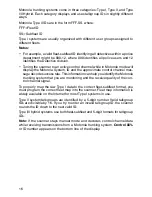
14
QUICK START
To help familiarize yourself with the scanner’s functions, keypad, and available
frequencies, you can utilize one of these four features before you begin pro-
gramming the scanner.
Spectrum Sweeper
– searches nearby strong signals quickly. See “Spectrum
Sweeper”.
Preprogrammed Search Banks
– allow you to listen to frequencies and de-
cide which frequencies you want to store when you are ready to program the
scanner. See “Searching a Preprogrammed Frequency Range”.
Manual Tuning
– allows you to manually move through the entire range of
available frequencies. (See “Specifications” for a list of the available frequency
ranges.)
Weather Radio
– allows you to listen to NOAA weather broadcasts without
programming. See “Listening to the Weather Band”.
Understanding Your Scanner’s Modes
You can program each channel with any of seven receive modes (AM, FM, CT,
DC, MO, ED, and LT).
Each receive mode affects how your scanner operates when scanning and
receiving transmissions.
Notes:
• Trunked modes (MO, ED, and LT) can only be selected for frequencies above
137 MHz.
• Your scanner’s closed mode lets you hear only those trunking talkgroups
you specify. For more information, see “Open and Closed Modes”.
AM mode
The AM mode sets the scanner to receive transmissions using amplitude modu-
lation (AM), primarily used for aircraft, military, some amateur radio, and some
government transmissions. When the scanner receives a transmission on a
channel set to the AM mode, it always stops on the transmission.
FM mode
The FM mode sets the scanner to receive transmissions using frequency modu-
lation (FM), used for most public safety transmissions, as well as broadcast,
business, and amateur radio transmissions. When the scanner receives a trans-
mission on a channel set to the FM mode, it always stops on the transmission.















































